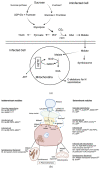Malate Transport and Metabolism in Nitrogen-Fixing Legume Nodules
- PMID: 34833968
- PMCID: PMC8618214
- DOI: 10.3390/molecules26226876
Malate Transport and Metabolism in Nitrogen-Fixing Legume Nodules
Abstract
Legumes form a symbiosis with rhizobia, a soil bacterium that allows them to access atmospheric nitrogen and deliver it to the plant for growth. Biological nitrogen fixation occurs in specialized organs, termed nodules, that develop on the legume root system and house nitrogen-fixing rhizobial bacteroids in organelle-like structures termed symbiosomes. The process is highly energetic and there is a large demand for carbon by the bacteroids. This carbon is supplied to the nodule as sucrose, which is broken down in nodule cells to organic acids, principally malate, that can then be assimilated by bacteroids. Sucrose may move through apoplastic and/or symplastic routes to the uninfected cells of the nodule or be directly metabolised at the site of import within the vascular parenchyma cells. Malate must be transported to the infected cells and then across the symbiosome membrane, where it is taken up by bacteroids through a well-characterized dct system. The dicarboxylate transporters on the infected cell and symbiosome membranes have been functionally characterized but remain unidentified. Proteomic and transcriptomic studies have revealed numerous candidates, but more work is required to characterize their function and localise the proteins in planta. GABA, which is present at high concentrations in nodules, may play a regulatory role, but this remains to be explored.
Keywords: legume; malate; metabolism; nitrogen fixation; nodules.
Conflict of interest statement
The authors declare no conflict of interest.
Figures


References
-
- Whitehead L.F., Day D.A. The peribacteroid membrane. Physiol. Plant. 1997;100:30–44. doi: 10.1111/j.1399-3054.1997.tb03452.x. - DOI
-
- Gavrin A., Kaiser B.N., Geiger D., Tyerman S.D., Wen Z., Bisseling T., Fedorova E.E. Adjustment of Host Cells for Accommodation of Symbiotic Bacteria: Vacuole Defunctionalization, HOPS Suppression, and TIP1g Retargeting in Medicago. Plant Cell. 2014;26:3809. doi: 10.1105/tpc.114.128736. - DOI - PMC - PubMed
-
- Mohd Noor S., Day D., Smith P. The Symbiosome Membrane. In: Bruijn F.J., editor. Biological Nitrogen Fixation. John Wiley & Sons; Hoboken, NJ, USA: 2015. pp. 683–694.
Publication types
MeSH terms
Substances
Grants and funding
LinkOut - more resources
Full Text Sources

